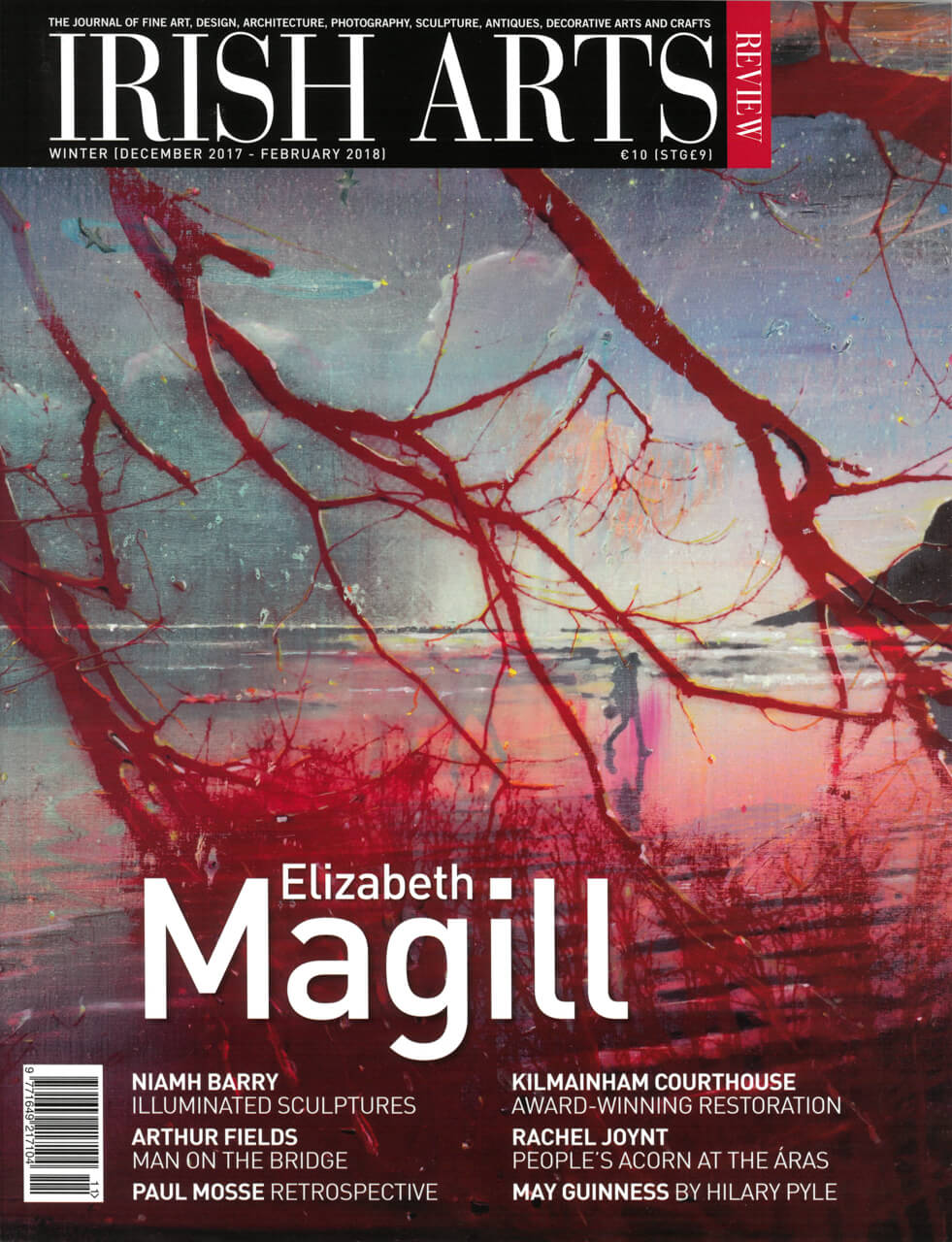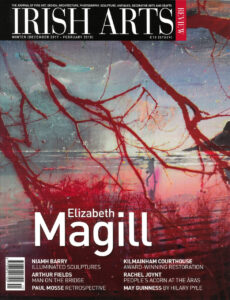

Carissa Farrell explores the civic values inherent in Rachel Joynt’s soon-to-be-unveiled 1916 commemorative commission, Dearcán na nDaoine, for the grounds of Áras an Uachtaráin
Sculptor Rachel Joynt’s many public art commissions have won her peer respect while enjoying an active resonance with the public that encounter them. Her signature process is to adopt organic forms as a conceptual starting point and then evolve and adapt their core qualities with glass, bronze, patination, embedded light, and moving image, while retaining a recognisable sense of their organic identity. In her public art practice, scale and location are key, where hand sized forms expand to ‘mythically surreal’ proportions and typically invoke uncanny and playful connections to their environment. Joynt is very interested in the idea of place and meaning and the need to acknowledge the insight of the public in an active and relevant exchange. Her technical skill and understanding of the complex structural requirements of working with permanent materials underpins the authenticity of her intentions and her commitment to the aspiration that public art is an important civic endeavour. She is well rewarded by the popularity her work enjoys.
Joynt is in the process of completing a new commission for President Michael D Higgins and Sabina Higgins, at Áras an Uachtaráin, to celebrate the centenary of the 1916 Rising. In keeping with her methodology she proposed to cast a giant acorn in bronze, People’s Acorn / Dearcán na nDaoine. An intrinsically elegant ornament of nature, the acorn is long beloved of the art and design world. In the hand they are a jewel, whose smooth nut is set into a tiny foliage embossed cupula and an object of great affection for children in autumn. They have provided an allegory for a multitude of ideas and values for centuries – learning, growth, strength, longevity and regeneration. For Joynt the acorn symbolises the cycle of life, in her proposal she wrote, ‘The nut/seed determines the form of the tree and in turn the tree nurtures the seed…’
‘The acorn, I feel is a very appropriate and enduring symbol to commemorate the centenary of the birth of our National Independence and our aspiration towards growing with maturity, optimism and wisdom for the future’.
Her choice of the acorn is a suitable metaphor, but also reflects the more difficult legacies arising from the Rising and the subsequent War of Independence for those who may not easily consider those events as wholly in the ‘past’ or sufficiently removed from the present for a commemorative project that represents closure. The acorn is not an oak tree – it is not yet rooted, old and wise, but it is alive with potential and possibility, and this was the key for Joynt, ‘The acorn, I feel is a very appropriate and enduring symbol to commemorate the centenary of the birth of our National Independence and our aspiration towards growing with maturity, optimism and wisdom for the future’.
Part and parcel of her proposal was for the internal space of Dearcán na nDaoine to become a time capsule, filled with writings and messages for future generations. This content would be produced from workshops with collaborating poet Enda Wyley involving cross-generational groups of fifth-class primary schoolchildren from seven schools nationwide, and older people from the Bealtaine Writers Group and the Lourdes Day Centre in Seán McDermott Street. In reference and homage to its contents, the external texture of Joynt’s sculpture is cleverly rendered by casting thousands of pencils into the bronze, many embossed with the names of the schoolchildren who took part and donated their pencils and outwardly reflecting their multi-cultural backgrounds as diverse as China, Eastern Europe, the Middle-East and Africa (Figs 1-4). Mary Robinson’s presidency transformed the Áras into a symbolic refuge for all citizens – a gesture continued by both Mary McAleese and Michael D Higgins turning the Áras into a very visible platform for embracing diversity. The People’s Acorn / Dearcán na nDaoine will represent a permanent and tangible symbol of this aspiration.
Towards the tip of Dearcán na nDaoine extracts of the writings and poetry will fan out along its ribbed surface while a more complete compilation of the texts will form a publication to accompany the commission. Inevitably there is a marked contrast in the content of the writing between the children and older people, who reflect on the hardship of their childhood while being nostalgic about the loss of innocence and changing social norms over the last sixty years. Compared to the worldly schoolchildren their frame of reference is activated by memory and introspection. It is no surprise that in the information age the children seem unanimously and acutely aware of a sense of national and international crisis – around homelessness in Ireland and displacement and war in the wider world. What is striking is how these observations are mixed with happier narratives of friends, family, pets and toys thereby contextualising their concerns with an understated awareness of their position of relative privilege. Appropriately for a time capsule, the greatest commonality between the children and older people are enduring themes of social stability – family, togetherness, and community.
One of the most remarkable characteristics of an oak tree is its lifespan’s potential to straddle the period of Ireland’s pre- and post-colonial history. The oak or Dair, was one of the Airig Fedo or Lords of the Woods and is described in the 8th-century Brehon law text Bretha Comaithchesa as one of seven most valuable trees subject to specific protections and punishments for legal breaches. The choice of the acorn for this commission symbolises the possibility of restoring a continuum from the old Gaelic order to the fledgling Irish State one hundred years ago. Coupled with this, Joynt’s use of monumental scale for such a tiny form brings to mind the supernatural narratives of ancient Irish legends and later fairy folklore. Its large tectonic bronze presence, laying sideways and covered with embedded texts and pencil shapes engenders an almost pagan ritualistic sensibility that points to Ireland’s rich heritage from the Neolithic period. Joynt’s choice of location for Dearcán na nDaoine in an area of natural woodland where many oaks are growing was deliberate, accessed by a mesh path through which grass could grow camouflaging it entirely from view and enhancing the illusion that Dearcán na nDaoine is the result of some kind of unearthly magic. The co-ordination of each element of the design and placement is carefully considered by Joynt whose objective is to maximise the potential of the Dearcán na nDaoine to actively resonate with its environment and audience. Her vision and technical capacity to deliver illustrates a sensitive and intelligent understanding of the true potential of public art. The only pity is that more work like this is not discreetly arranged in unexpected locations throughout the Phoenix Park.
Joynt’s success as a public artist working to complex engineering requirements has not diminished her capacity for producing powerfully intimate pieces for gallery exhibition. Earlier this year, Joynt was the recipient of the Solomon Fine Art Award at the RHA Annual Exhibition for River Goddess Series II, a graceful figurine-like representation of the highly endangered freshwater pearl mussel whose special areas of conservation include the Slaney, Barrow and Nore rivers, practically on the doorstep of Joynt’s studio and home. Cast in bronze and nickel plate she presents the mollusc in an unlikely upright position and returns to her playful instincts by bestowing a majestic title on such a fragile and passive organism (Fig 5). The exterior surface has a tough slate texture as though shielding its precious glimmering pearl and gold lining from the elements, and indeed, environmental pollution. It is conjoined to its own perfectly measured elegant plinth – a recurring feature in Joynt’s small work.
Joynt’s vision and technical capacity to deliver illustrates a sensitive and intelligent understanding of the true potential of public art
In producing work for exhibition her approach to scale is skilfully inverted by incorporating light, video, glass and metal elements in astonishing miniature. For the series ‘Sea Change’ Joynt constructed a series of delicate exoskeletal mollusc forms in bronze (Fig 7). Their hybrid appearance mingles references to loaves of bread, embroidery, human organs and sea creatures. Tiny apertures in the bronze casing project internal illuminations outward, activating the internal space and endowing them with an otherworldly consciousness and supernatural possibilities. Like River Goddess Series II each work in this series incorporates is own beautifully hewn Portland stone plinth. A coin-sized image of Joynt floating in open water forms the central aperture of Buoyant and in Murmuration, a cast-bronze animal heart conceals a miniscule looped video of a flock of starlings in flight in one of its arteries. These startling entities seem to peer inside the subconscious or perhaps consciousness in an alternate dimension. A wall-mounted work Surge approximates the form of a human heart pulsing with light from within and a work from a later series, the playfully titled Fathom mutates a sea coral into the profile of a human brain that is perilously perforated as a result. These works are delicate, intricate and require close examination to be fully appreciated.
Rachel Joynt collaborates from time to time with partner artist Remco de Fouw. Theirs is Ireland’s best-known work of public art, Perpetual Motion at the Naas bypass Co Kildare, a family favourite whose visual impact is as strong as it is playful, it has stood the test of time and popularity since 1996. Joynt and de Fouw more recently completed Waggle Dance for NUIM, University of Ireland, Maynooth (Fig 6). Set in a shallow lake-like water feature outside the Iontas building designed by Scott Tallon Walker, this substantial plate bronze partial sphere is made with open sections that reveal its internal cellular structure. Inspired by the complex architecture of a bee-hive it reflects on the ‘creativity, intellectual endeavour and commonality behind the activity of the university through the geometry, complexity and ecology associated with the beehive’. It also represents the growing synergy between the organic world and the built environment and points to the increasing tendency for engineering and science innovation to harmonise itself with ecological and environmental sustainability. Early next year Joynt and de Fouw will complete a related but much larger work based on this design for a public space in Sandyford.
Carissa Farrell is an independent writer on art based in Dublin.



